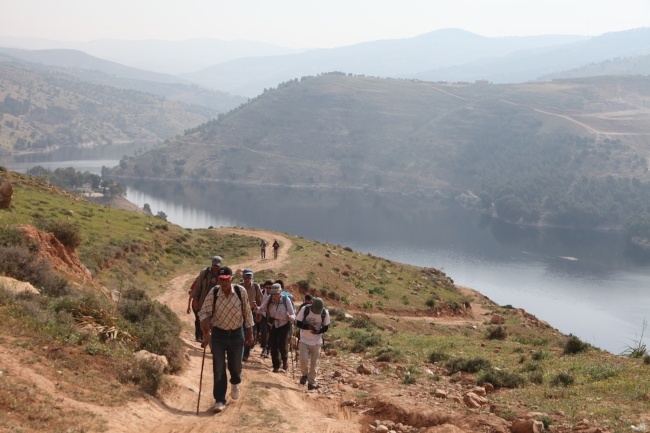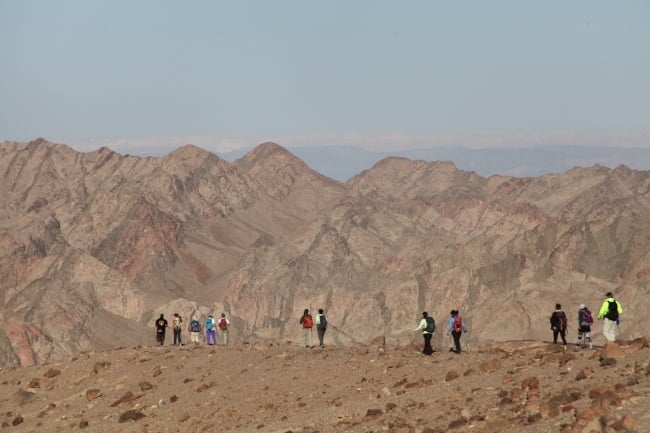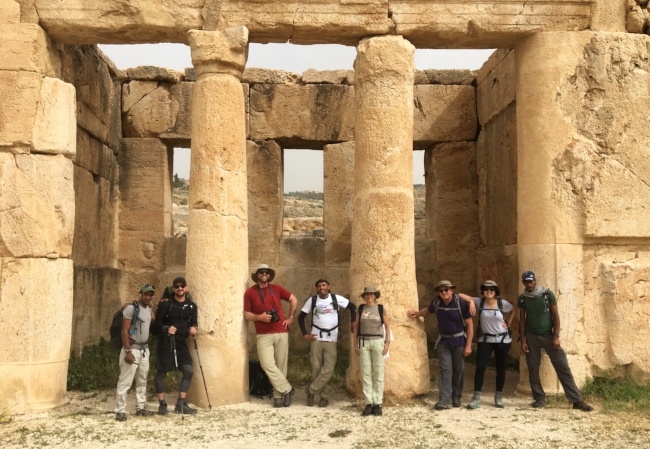 It’s getting harder and harder to stick my tent pegs into the ground.
It’s getting harder and harder to stick my tent pegs into the ground.
Up north, the bright copper hooks sunk into the soil like fingers in sand. A week later I had to work the pegs into the earth, pulling them out all crooked in morning. Another week passed before we hit solid rock—by then I had given up completely and followed the advice of our fail-proof Bedouin guides, dropping pumpkin-sized boulders on the inside corners of my tent and praying the outstanding wind did not carry me away in the nighttime. Now I know why everything in Jordan is built from stone—it’s the only thing that doesn’t blow away.
My third week on the Jordan Trail opened in the two-thousand-year old ruins of Iraq Al-Amir—an immense rectangle palace, also built from stone some. Hiking through the slender Greek columns made for a cinematic gateway as we dropped down into the slanted valley and began our longest walking day yet.
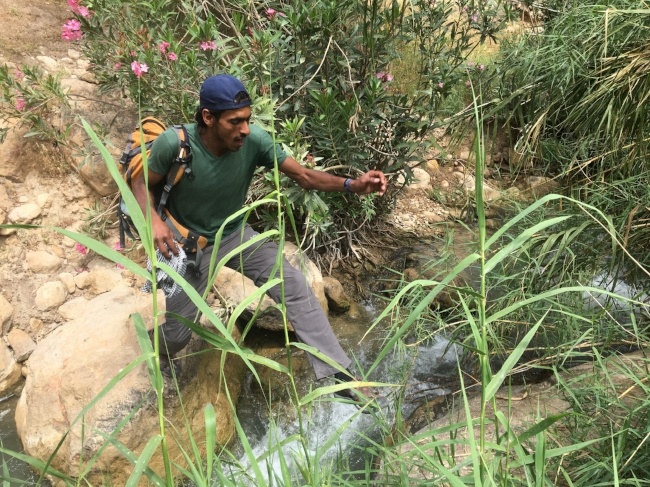 By now our group of hikers had diminished—there were less than ten of us skidding down into the valley, including a few new hikers joining us for this third section of the trail. Meanwhile, the heat had increased, so that by 9 AM, I was already sweating like a man who emerges from a 15-minute sauna. It was in this new sultry wave of humid heat that we encountered our first wadi—a clear river of rainwater, gushing through the rocks and surrounded by green bamboo and bushes of light sweet-smelling pink flowers. One by one, we leapt across, pushing our way through the brief and sweltering jungle before emerging on the other side and facing the truth—a near vertical wall of dirt for which there is no easy way up.
By now our group of hikers had diminished—there were less than ten of us skidding down into the valley, including a few new hikers joining us for this third section of the trail. Meanwhile, the heat had increased, so that by 9 AM, I was already sweating like a man who emerges from a 15-minute sauna. It was in this new sultry wave of humid heat that we encountered our first wadi—a clear river of rainwater, gushing through the rocks and surrounded by green bamboo and bushes of light sweet-smelling pink flowers. One by one, we leapt across, pushing our way through the brief and sweltering jungle before emerging on the other side and facing the truth—a near vertical wall of dirt for which there is no easy way up.
The only way up is up, and the Jordan Trail has taught me that “up” only happens in single footsteps, lifting one leg after the other, every muscle working to push my body and backpack up and over the hill. Once we had all reached the top of our first impressive ascent, huffing away and beet-faced, we discovered a small patch of civilization and became exuberant at the unassuming roadside shop that sold beach balls, swimsuits, and sun hats for vacationers headed down to the Dead Sea.
Like overheated zombies, we crowded the shop’s outdoor refrigerator, pulling out cold soda, ice water, and yogurt drinks. Then we entered the shop and began rifling through boxes of chips, cookies, and salty snacks—as if rummaging through our own cupboards back home. I presume the kindly shopkeeper, Um Youssef, might have found our bulky presence unnerving, but once we started dropping cash and explained that we were not merely lost and deranged heat stroke victims, but in fact, hikers on our way to Aqaba, she perked up and turned all matronly, guiding some to the shop’s private restroom, ringing up so many popsicles and ice cream cones to cover our next eager craving.
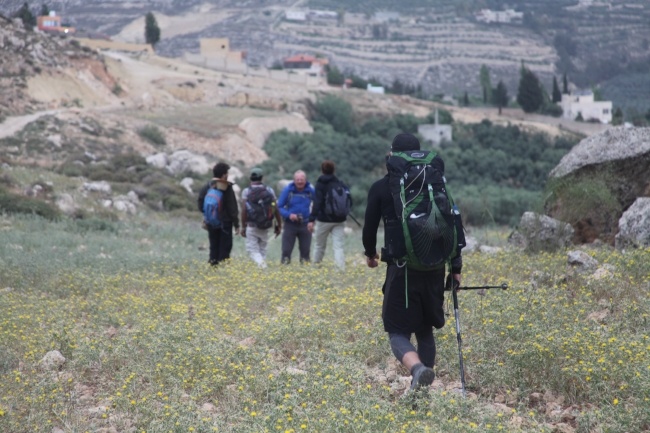 But so quickly, this small oasis of manmade comfort vanished behind us, and climbing even higher, we entered another realm—almost mystical—where a forest of bristly pine trees made the air smell alive and ready. The invisible rain hit us unexpectedly, just as we were finishing up our teatime beneath the trees. It disappeared just as quickly, leaving the world fresh and my face wet, with rivers running down my glasses. The real gift of the Jordan Trail is total immersion in nature—It might be the rain or wind, dust and stone, the frogs and stars at night, and the busy lizards that run faster than my eyes. And it is the people who live in this nature, moving with its ever-changing colors and seasons.
But so quickly, this small oasis of manmade comfort vanished behind us, and climbing even higher, we entered another realm—almost mystical—where a forest of bristly pine trees made the air smell alive and ready. The invisible rain hit us unexpectedly, just as we were finishing up our teatime beneath the trees. It disappeared just as quickly, leaving the world fresh and my face wet, with rivers running down my glasses. The real gift of the Jordan Trail is total immersion in nature—It might be the rain or wind, dust and stone, the frogs and stars at night, and the busy lizards that run faster than my eyes. And it is the people who live in this nature, moving with its ever-changing colors and seasons.
It was late afternoon when I saw the sheep—a hundred or so, brown and white, neck and neck, all tied up together in a row as the daughters of the family busied themselves with milking the ewes one by one. Milking sheep is a rare skill that barely resembles milking a cow—or even a goat. I speak as a man of experience, having milked cows and goats on several continents—but until this rare moment atop a mountain near Husban, I had never attempted to milk a sheep.
 According to the Mohammadin (our pair of guides who are both named Mohammad—both of them lifelong shepherds), the trick is pulling the heavy udder between the sheep’s legs and then squeezing above the bulbous teat. Success equals a long squirt of sheep milk that splashes melodically in the white plastic bucket. Failure is no milk at all and one disgruntled sheep that knows she is dealing with a clumsy amateur. I speak as a man of experience, as I knelt behind that sheep and milked away, with barely any results other than soaking my hand once with drips of wayward milk. The patient Bedouin family kept stepping in to show me the flaws of my technique—it’s all in the wrist and fingertips—both we all soon realized that I was hopeless. Milking sheep is not the kind of craft you can just pick up and suddenly go pro. These Bedouin girls had been milking sheep for years, and I watched their deft hands get to the task where I had failed, filling up the foamy bucket and then releasing the patient sheep, who quickly ran away from us like kids released from school.
According to the Mohammadin (our pair of guides who are both named Mohammad—both of them lifelong shepherds), the trick is pulling the heavy udder between the sheep’s legs and then squeezing above the bulbous teat. Success equals a long squirt of sheep milk that splashes melodically in the white plastic bucket. Failure is no milk at all and one disgruntled sheep that knows she is dealing with a clumsy amateur. I speak as a man of experience, as I knelt behind that sheep and milked away, with barely any results other than soaking my hand once with drips of wayward milk. The patient Bedouin family kept stepping in to show me the flaws of my technique—it’s all in the wrist and fingertips—both we all soon realized that I was hopeless. Milking sheep is not the kind of craft you can just pick up and suddenly go pro. These Bedouin girls had been milking sheep for years, and I watched their deft hands get to the task where I had failed, filling up the foamy bucket and then releasing the patient sheep, who quickly ran away from us like kids released from school.
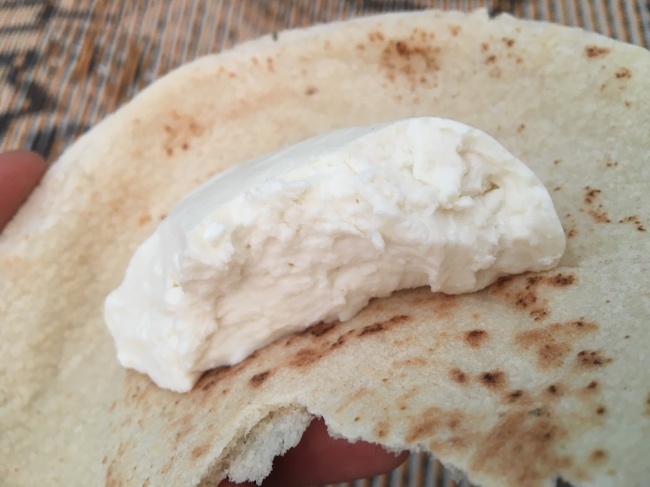 Accepting that I am unfit to survive as a herder, we bought a full kilo of the family’s homemade cheese—fresh, white, smooth, and extra salty. The young son ran out from their woven goat’s wool tent, lifting the bundle like the prize that it was—a treasure that began as this same hard-packed earth, watered with rain, and arriving to us gradually through herbs and hungry sheep, their rich milk, and finally as the cheese we munched along the path, waving farewell to our sudden friends.
Accepting that I am unfit to survive as a herder, we bought a full kilo of the family’s homemade cheese—fresh, white, smooth, and extra salty. The young son ran out from their woven goat’s wool tent, lifting the bundle like the prize that it was—a treasure that began as this same hard-packed earth, watered with rain, and arriving to us gradually through herbs and hungry sheep, their rich milk, and finally as the cheese we munched along the path, waving farewell to our sudden friends.
It was dark by the time we reached camp—too dark for me to see my tent as I unfurled it like a pennant in the wind. A distant crack of thunder announced the second wave of rain, harder and heavier than the earlier wave and with the kind of comedic timing seen on cheaply-scripted TV shows. In three minutes, my pack, my self, and the inside of my tent were all soaked. It stopped as quick as it began, and so, dripping in the dark, I resumed the construction of my night’s shelter—toweling off the interior of the tent, dropping stones in the four corners, unrolling my sleeping bag and inhaling the smell of the just-washed land. Almost dry, I closed my eyes and let the wind rock me to sleep.
Follow my personal adventure on social media with #AndrewWalksJordan and #ThruJT and on the Andrew Walks Jordan homepage.




